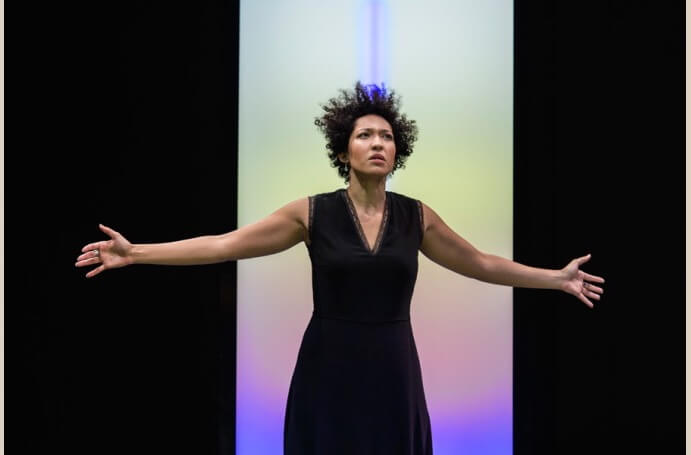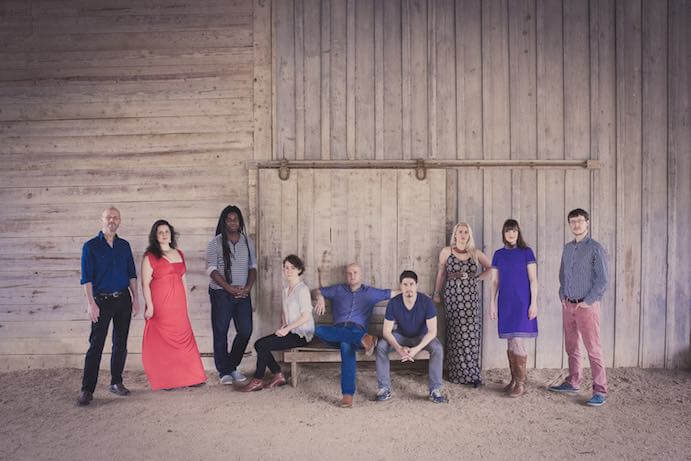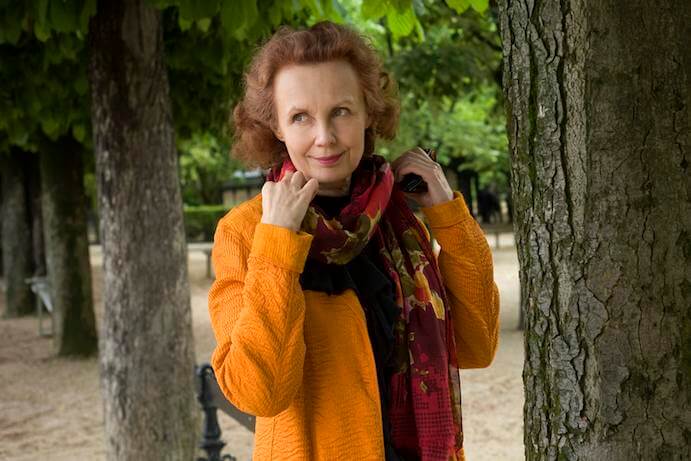The third “station” of Kaija Saariaho‘s La Passion de Simone begins with two tumults of sound separated by pronounced silence, ushering in one of the piece’s most musically and textually violent episodes. On Thursday night in Ojai’s Libbey Bowl, the entire audience and ensemble took that collective breath, and three crows flew overhead, letting out harsh caws. “My hope is that all of you across the weekend will respond to this music as personally as possible,” 2016 Ojai Music Festival music director Peter Sellars had commented from the stage before the concert began. Presumably, the crows heard him.
La Passion de Simone is a deeply personal piece for the composer. “I consider this piece my most important one,” Saariaho said during a talk a few hours before the concert. “In a way, it is my legacy.” The piece could be called an oratorio or a monodrama. It is a response and homage to the life and work of 20th century thinker and radical activist Simone Weil, who the composer described as having been haunting her since she picked up a Finnish translation of Gravity and Grace as a teenager. Librettist Amin Maalouf created an address to Weil, accusing and praising in the same breath, putting Weil back in the family she abandoned. “My big sister, my little sister,” the soprano soloist sings. “I admire you for making your life a luminous passage, but I resent that you preferred death.”

Julia Bullock as Simone Weil– Photo by Ruth Walz
Weil’s words on life, love, and humanity are difficult and divisive; one sentence could be easy to accept, the next flagrantly inflammatory, the next profoundly relatable again. While holding a PhD from the Sorbonne, she went to work in a factory to understand the plight of laborers, but her fragile health forced her out. Some years later, she tried to join the French Resistance–giving up the safety her family had found in New York–but the other fighters found her lack of physical aptitude a burden. She starved herself to death in England at the age of thirty-four, surrounded by friends and ample food, claiming she could not eat while her French countrymen were starving.
The soprano Julia Bullock is only a few years younger than Weil was at her death, and in her performance, she embodied the power of Weil’s legacy. Her expressive, unclouded voice sailed on the border between Weil’s two opposing universal forces, “light and gravity.” Bullock was illuminated from behind by Ben Zamora’s door-shaped LED box, a “luminous passage” all its own in morphing color. She spoke the short excerpts of Weil’s thorny prophecies as though she channeled her spirit, her posture snapping upright, her short Afro becoming a glowing halo. As a perfect spiral is at home in a nautilus shell, Bullock is at home in this role, exalting in the light and being pulled to the ground by the sheer immensity.

International Contemporary Ensemble
This performance was the American premiere of the piece’s chamber version, which was adapted from the 2005 edition for full orchestra and choir. Conductor Joana Carniero manipulated her baton like a possessed paintbrush, eliciting vivid colors and tangible textures from the ever excellent International Contemporary Ensemble. During the “stations” depicting Weil’s factory work, percussion clanked and strings whined, concrete machines in sharp contrast to the rest of Saariaho’s sound-based, abstract soundscape. The original edition’s fiery pillar of an SATB choir was cut down to four members of Roomful of Teeth, one on a part. Their voices sometimes came through as distinct beams of light, sometimes merged into a seamless blend. If the original is a grand requiem, the chamber version is personal devotion.

Roomful of Teeth–Photo by Bonica Ayala
“Attention is the purest form of generosity,” Weil wrote, and Sellars aims to enable that generosity throughout the festival by limiting the length of each concert, turning each into ritual. No concert has an intermission, each is supposed to run under approximately 75 minutes, and each is scheduled for a deliberate time of day; morning meditation, the mystic hour in the afternoon, late night, or the transformation of twilight, like this one. Night fell, the crescent moon emerged, and the crickets seemed to at once mourn the dying Simone and remind the world that it still lives and turns.























